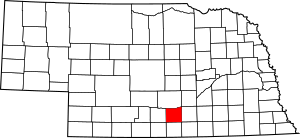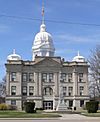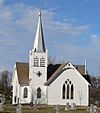National Register of Historic Places listings in Kearney County, Nebraska facts for kids
Welcome to Kearney County, Nebraska! This article is all about special places in the county that are listed on the National Register of Historic Places. Think of this register as a very important list of buildings, sites, and objects that are worth saving. They tell us a lot about the history of the United States.
These places are important because they show us how people lived, worked, and built communities long ago. When a place is on this list, it means it's recognized for its history, architecture, or what it means to our culture. In Kearney County, there are 8 amazing places that have earned a spot on this special list.
You can even see where these places are on an online map if you look up their coordinates!
What is the National Register of Historic Places?
The National Register of Historic Places is the official list of the nation's historic places. It is part of a program to coordinate and support public and private efforts to identify, evaluate, and protect America's historic and archaeological resources. When a place is listed, it gets special recognition and can sometimes get help for its preservation.
Historic Places in Kearney County
Let's explore some of the cool historic spots you can find in Kearney County!
| Name on the Register | Image | Date listed | Location | City or town | Description | |
|---|---|---|---|---|---|---|
| 1 | Bethphage Mission |
(#13000199) |
1044 23rd Road 40°29′13″N 99°07′16″W / 40.486829°N 99.121231°W |
Axtell vicinity | The Bethphage Mission is a historic site near Axtell. It was founded in 1913 by Swedish immigrants. The mission provided care for people with disabilities. It includes several buildings, like the Zion Chapel, which show the mission's long history of helping others. | |
| 2 | Eddie Eugene and Harriet Cotton Carpenter Farmstead |
(#93000059) |
Approximately 0.5 miles west of Lowell 40°38′54″N 98°51′31″W / 40.648333°N 98.858611°W |
Lowell | This farmstead belonged to the Carpenter family. It shows what a typical farm in Nebraska looked like in the late 1800s and early 1900s. It helps us understand the farming history of the area. | |
| 3 | Dobytown |
(#74001125) |
Southwest of Kearney 40°38′30″N 99°02′51″W / 40.641667°N 99.047500°W |
Kearney | Dobytown was an important frontier settlement. It was a stopping point for travelers on the Oregon Trail and Mormon Trail. It played a big role in the early development of Nebraska. | |
| 4 | Fort Kearney |
(#71000485) |
2 miles west of Newark on Nebraska Highway 10 40°38′36″N 99°00′25″W / 40.643333°N 99.006944°W |
Newark | Fort Kearny was a military fort built in 1848. It protected pioneers traveling west on the Oregon Trail. It was a vital outpost for travelers and played a key role in the history of the American West. | |
| 5 | Kearney County Courthouse |
(#89002234) |
5th St. between Colorado and Minden Aves. 40°29′56″N 98°56′53″W / 40.498889°N 98.948056°W |
Minden | The Kearney County Courthouse is a beautiful building in Minden. It was built in 1909 and is known for its impressive architecture. It has been the center of local government for over a century. | |
| 6 | Salem Swedish Methodist Episcopal Church |
(#82003192) |
Southwest of Axtell 40°27′11″N 99°10′42″W / 40.453056°N 99.178333°W |
Axtell | This church was built by Swedish immigrants. It shows the strong influence of Swedish culture and religion in the area. It is a great example of early church architecture in rural Nebraska. | |
| 7 | W. T. Thorne Building |
(#85002139) |
5th St. 40°29′59″N 98°56′54″W / 40.499722°N 98.948333°W |
Minden | The W. T. Thorne Building is located on 5th Street in Minden. It is an important historic building that has been part of the town's main street for many years. It reflects the commercial history of Minden. | |
| 8 | US Post Office-Minden |
(#92000471) |
410 N. Minden St. 40°29′55″N 98°56′50″W / 40.498732°N 98.947358°W |
Minden | The Minden Post Office is special because it has a beautiful mural inside. The mural, painted in 1939, is called "1848-Fort Kearney, Protectorate on the Overland Trail-1871." It tells a story about the area's history. |









